
How To Place An Image In Text With Photoshop CC and CS6
In this tutorial, we learn how to place an image in text, one of Photoshop's most popular and classic effects. As we'll see, thanks to the power of clipping masks, placing an image inside text with Photoshop is simple and easy. I'll be using Photoshop CS6 here but this tutorial is fully compatible with the latest version of Photoshop up to 2023. If you're using an older version of Photoshop, be sure to check out my original Placing An Image In Text tutorial.
Here is the image I'm using (tropical beach sunset photo from Adobe Stock):

And here's what the same image will look like when placed inside text:
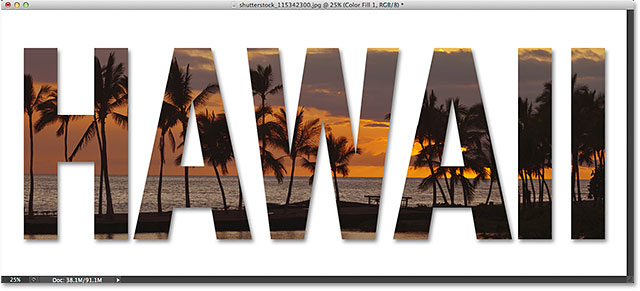
Let's get started!
How To Place An Image In Text With Photoshop
Step 1: Duplicate The Background Layer
Open the image you want to place inside your text. With the image newly opened, if you look in your Layers panel, you'll see the image sitting on the Background layer, currently the only layer in the document:
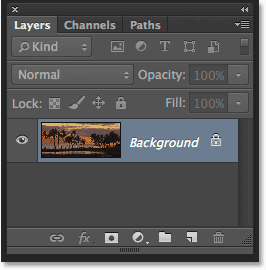
We need to make a copy of this layer. Go up to the Layer menu in the Menu Bar along the top of the screen, choose New, then choose Layer via Copy. Or, you can select this same command from the keyboard by pressing Ctrl+J (Win) / Command+J (Mac):
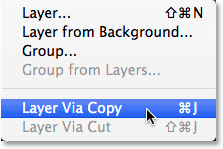
Photoshop creates a copy of the layer, names it "Layer 1", and places it directly above the Background layer:
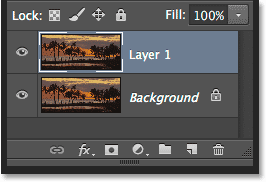
Step 2: Add A White Solid Color Fill Layer
Next, let's add one of Photoshop's Solid Color Fill layers to use as the background for our effect. Click on the New Fill or Adjustment Layer icon at the bottom of the Layers panel:
Choose Solid Color from the top of the list that appears:
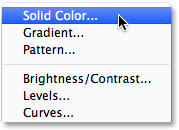
Photoshop will pop open the Color Picker so we can choose the color we want to fill the layer with. I'm going to use white for my background color by entering a value of 255 into the R, G and B boxes:
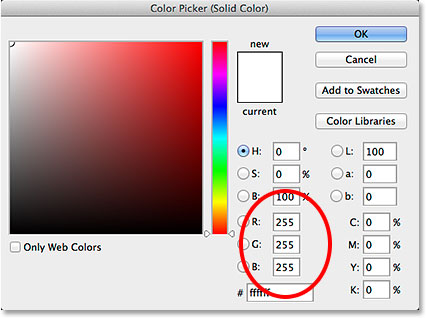
Click OK to close out of the Color Picker. Back in the Layers panel, we see the white Solid Color Fill layer (named "Color Fill 1") sitting above the two image layers:
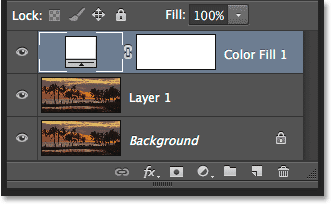
And because the Fill layer is sitting above both of our image layers, the document is now temporarily filled with white:
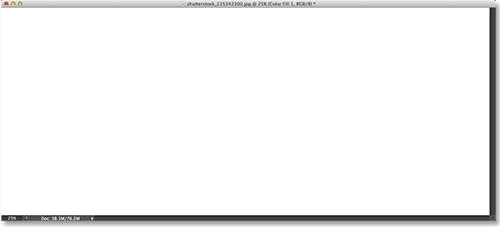
Step 3: Drag The Solid Color Fill Layer Below Layer 1
We need to move the Solid Color Fill layer below Layer 1. Click on the Solid Color Fill layer (make sure you click on its little color swatch icon on the left, not the layer mask icon on the right), and with your mouse button still held down, drag the layer downward until you see a highlight bar appear between the Background layer and Layer 1:
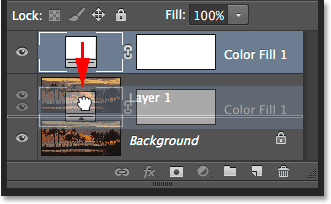
Release your mouse button when the highlight bar appears to drop the Fill layer into place between the two image layers. Your image will reappear in the document window:
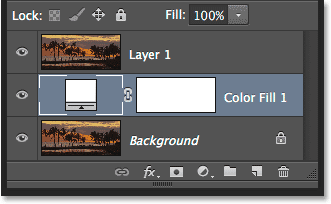
Step 4: Select Layer 1
Click on top layer (Layer 1) in the Layers panel to select it:

Step 5: Select The Type Tool
We're ready to add our text. Select Photoshop's Type Tool from the Tools panel along the left of the screen. You can also select the Type Tool simply by pressing the letter T on your keyboard:

Step 6: Choose Your Font
With the Type Tool selected, go up to the Options Bar along the top of the screen and choose your font. Since our goal is to place an image within the text, generally fonts with thick letters work best. I'm going to choose Arial Black, but of course you can choose any font you like. Don't worry about the font size for now. We'll resize the type manually later:

Step 7: Set Your Type Color To White
This next step isn't absolutely necessary, but to help us see the text as we're adding it, let's set our type color to white. If your type color is already set to white (or some other color you can easily see in front of your image), you can skip this step. To change the type color, click on the color swatch in the Options Bar:

This once again opens the Color Picker. I'll choose white just as I did before by entering a value of 255 for the R, G and B options. Click OK when you're done to close out of the Color Picker:
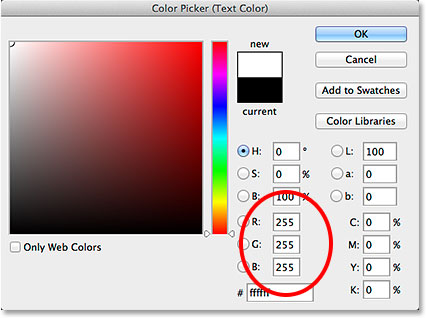
Step 8: Add Your Text
With your Type Tool selected, your font chosen and your type color set to white, click inside your document and add your text. I'll type the word "HAWAII":
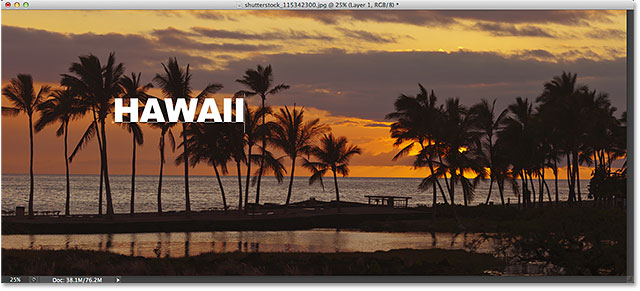
Click the checkmark in the Options Bar when you're done to accept your text and exit out of text editing mode:

Learn all about working with type in Photoshop with our Photoshop Type Essentials tutorial!
Step 9: Drag The Type Layer Below Layer 1
If we look in the Layers panel, we see our newly added Type layer sitting above Layer 1, which is why the text is appearing in front of the image in the document:
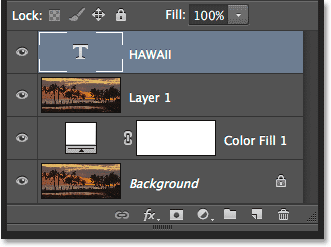
We need to move it below Layer 1. Click on the Type layer and, with your mouse button still held down, drag it downward until you see a highlight bar appear between Layer 1 and the Solid Color Fill layer:
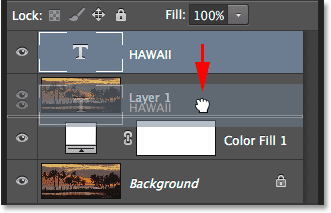
Release your mouse button when the highlight bar appears to drop the Type layer into place:
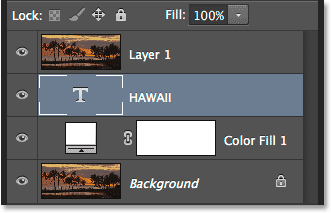
Step 10: Select Layer 1 Again
Click once again on Layer 1 to select it and make it active:
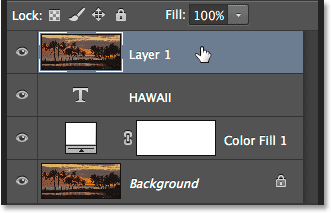
Step 11: Create A Clipping Mask
With Layer 1 selected, click on the small menu icon in the top right corner of the Layers panel:
Choose Create Clipping Mask from the menu that appears:
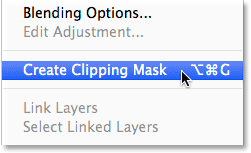
This clips the image on Layer 1 to the text on the Type layer below it, meaning that only the area of the image that sits directly above the actual text on the Type layer remains visible, creating the illusion that the image is inside the text. The rest of the image is now hidden from view, and in its place, we see the solid white Fill layer:
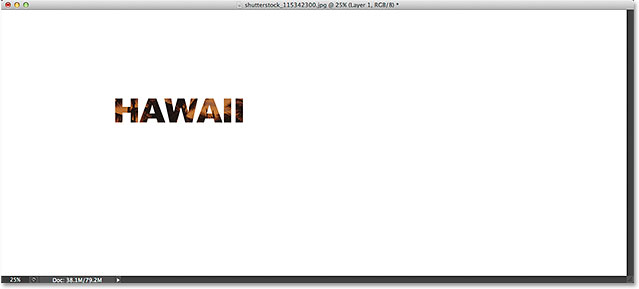
If we look again in the Layers panel, we see that Layer 1 has been indented to the right, with a small arrow pointing down at the Type layer below it. This is how Photoshop lets us know that the Type layer is being used as a clipping mask for Layer 1:

Related tutorial: How Photoshop Clipping Masks Work
Step 12: Select The Type Layer
Click on the Type layer to select it and make it active:
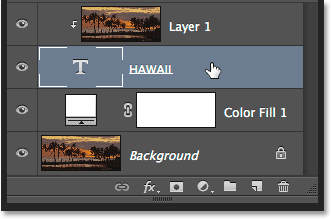
Step 13: Resize And Reposition The Text
All that's left to do now is to move and resize the type, and we can do both of those things using Photoshop's Free Transform command. With the Type layer selected, go up to the Edit menu at the top of the screen and choose Free Transform. Or, press Ctrl+T (Win) / Command+T (Mac) on your keyboard to select Free Transform with the shortcut:
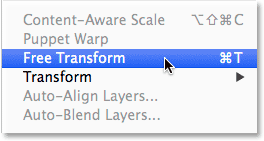
This places the Free Transform box and handles (the little squares) around the text. To resize it, simply click and drag any of the handles. If you want to resize the type without distorting the original shapes of the letters, hold down your Shift key as you drag any of the four corner handles. You can also resize the text from its center by holding down the Alt (Win) / Option (Mac) key as you drag. Finally, to move the text, click inside the Free Transform box and drag it into position with your mouse:
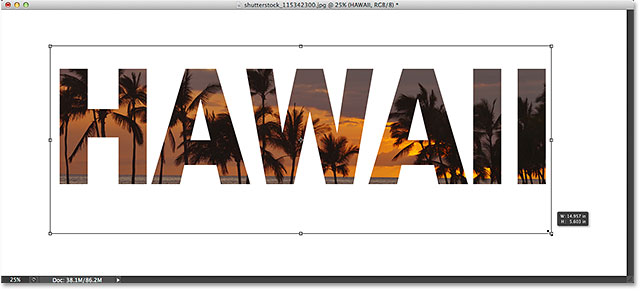
When you're done, press Enter (Win) / Return (Mac) to accept the transformation and exit out of Free Transform:
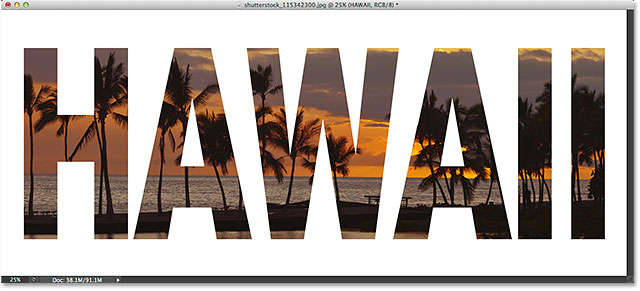
Step 14: Add A Drop Shadow (Optional)
This final step is optional, but to complete the effect, I'll add a drop shadow. If you want to follow along, with the Type layer still active, click on the Layer Styles icon (the "fx" icon) at the bottom of the Layers panel:
Choose Drop Shadow from the bottom of the list that appears:
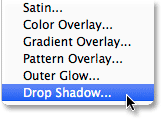
This opens the Layer Style dialog box set to the Drop Shadow options in the middle column. I’ll lower the Opacity of the drop shadow from its default value of 75% down to 50% to reduce its intensity, then I’ll set the Angle of the shadow to 120°. I'll increase my Distance value to 30px and the Size to 40px, but these two values depend a lot on the size of your image so you may need to play around with them on your own to find the settings that work best:
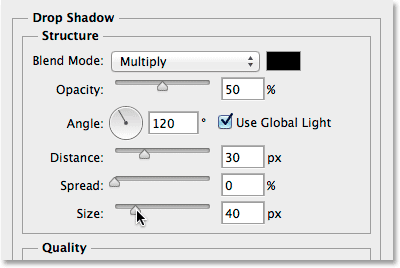
Click OK to close out of the Layer Style dialog box, and we're done! Here, after adding a drop shadow to the letters, is my final "image in text" result:

And there we have it! In this tutorial, we learned how to place an image in a single word, or a single Type layer. In the next tutorial, learn the trick to placing an image in multiple text layers at once! Or visit our Text Effects or Photo Effects sections for more Photoshop effects tutorials!